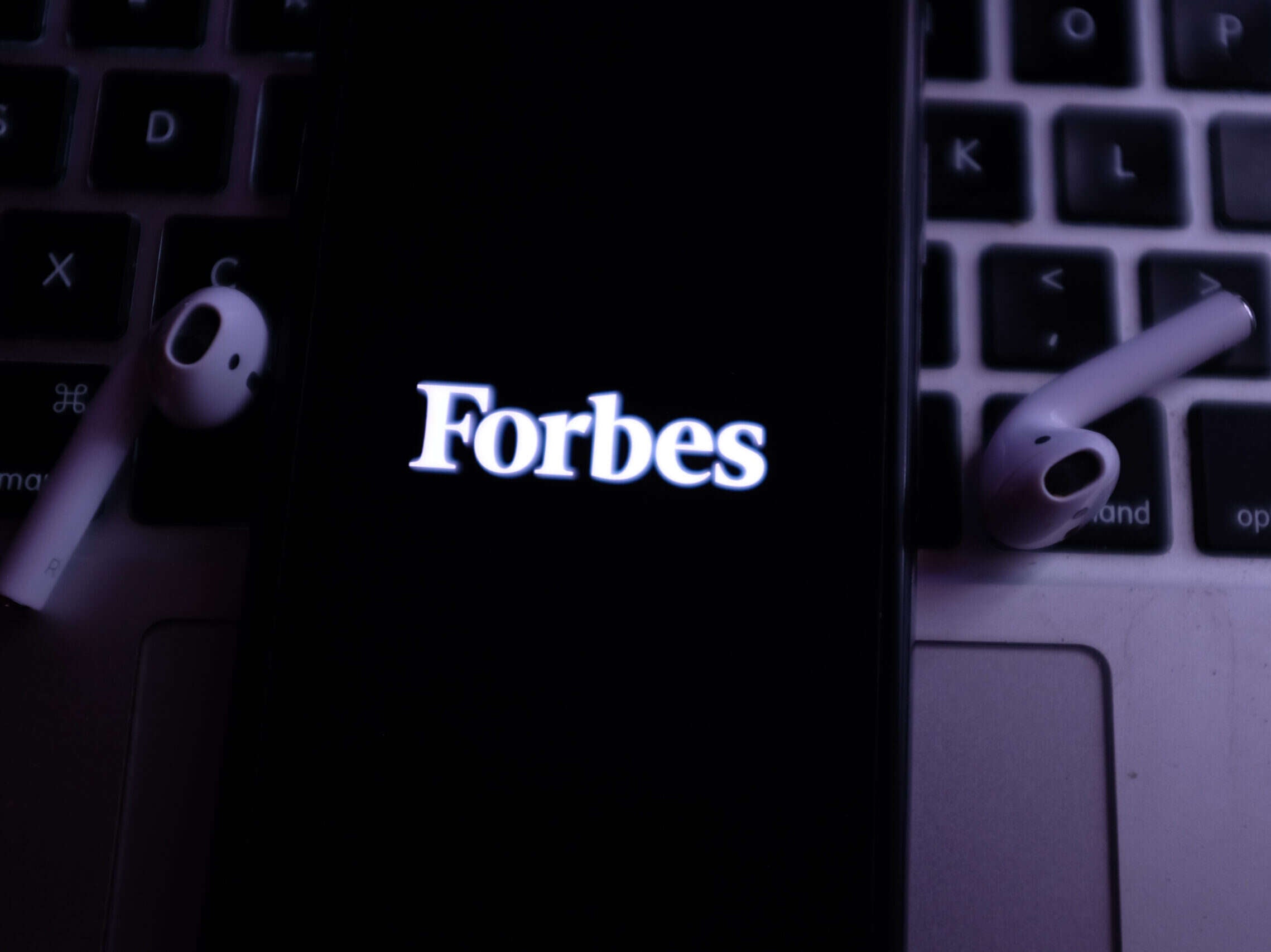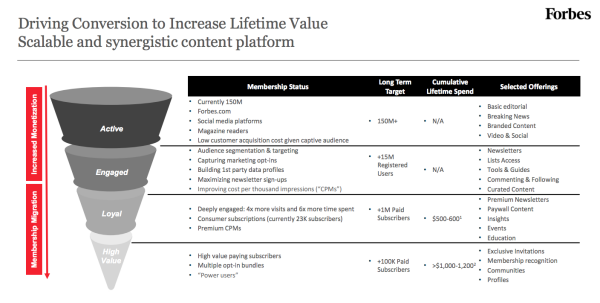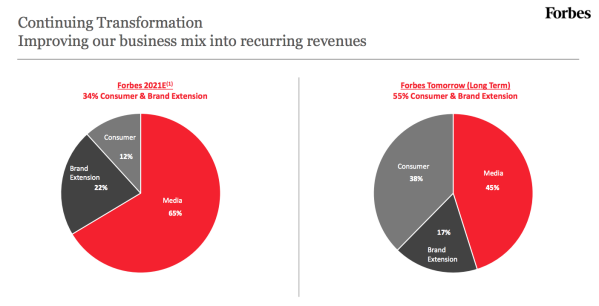
In 1917, Forbes was founded in New York City as a fortnightly business magazine.
In the coming months, it will enter the New York Stock Exchange as a digital media business worth $630m.
When chief executive Mike Federle first joined Forbes in 2011 (initially as chief operating officer), it was probably still best known to many for its print product.
But a decade on, after a period of experimentation and digital expansion, the magazine is expected to make up less than 10% of Forbes’ $211m revenues this year.
So, how has a finance-focused magazine managed to transform itself into a digital-first media business worth more than $600m?
“We positioned ourselves as a 90-year-old startup and really fostered an entrepreneurial sense inside the organisation,” Federle tells Press Gazette in a phone interview.
“The popular media opinion for many years was that a standalone single brand cannot make it in the media world – because of the cost involved, and being unable to advertise across multiple brands. But that proved to be totally false.”
Click here to subscribe to Press Gazette’s must-read newsletters, Future of Media and Future of Media US |
‘People said we were ruining journalism’
 A media industry veteran formerly of Time Inc and Fortune, Federle joined Forbes in 2011 as chief operating officer. Under the majority ownership of Hong Kong’s Integrated Whale since 2014, Federle was promoted to president in 2016 and has been chief executive since 2017.
A media industry veteran formerly of Time Inc and Fortune, Federle joined Forbes in 2011 as chief operating officer. Under the majority ownership of Hong Kong’s Integrated Whale since 2014, Federle was promoted to president in 2016 and has been chief executive since 2017.
In 2010, the year before Federle joined the business from conference startup Techonomy Media, Forbes launched BrandVoice, a native ad platform that enabled companies to self-publish on Forbes.com.
In the early years, says Federle, “people threw rotten tomatoes at us, said we were ruining journalism or ruining a great brand”. Today, native advertising is widely used by established media companies, though few are thought to offer marketers access to the back-end of their websites.
Forbes has spent the past 11 years building its business out into new areas through acquisitions and by launching new products.
“Forbes was really betting the ranch on a new model,” Federle says.
“At the time [when I joined the company] we referred to it as the new newsroom for a digital era, which now sounds so antiquated.
“But at the time it really was radical in terms of we kind of blew up the 100-year-old model of ad-supported media.”
Some innovations, like the 30 Under 30 brand, have paid off. Other innovations have withered away or been forgotten. And for many other new ventures – the Forbes Store, its newsletter business and the ForbesOne first-party data platform – it’s probably too soon to form a judgment.
Investors back the Forbes approach
Shareholders often crave certainty from their investments. But, despite the inherent uncertainty of experimental media companies, Forbes appears to have had little trouble finding investors.
The company announced plans last month to merge with Magnum Opus, a special-purpose acquisition company (SPAC), to list on the New York Stock Exchange at an initial value of $630m. As part of the deal, Forbes was able to raise $400m via a private investment in public equity (PIPE) arrangement.
“As we talked to investors, we were able to raise 2.5 times what we had planned to raise in the PIPE,” says Federle. “We raised $400m in the PIPE in an environment where no one’s raising that kind of money.
“It really became a testament not only to the brand and the numbers [posted by] the management team, but really the investors seemed to understand the opportunity that we presented.
“And I very much presented just as I talk to you: We have lots of opportunities to do a lot of different things.
“But we did not present any one thing as ‘this is going to be the next $50m business for us…’ We will develop products based on the data that we’re seeing and the reception.”
How does Forbes make money?
Ahead of its entrance to the public market, Forbes – like Buzzfeed earlier this year – has had to open its financial books to the world.
Its investor presentation (available here) forecasts revenues of $211m this year, and a profit of $44m (Ebitda).
Forbes’ media division is set to account for $138m, or 65%, of its total turnover. The magazine itself (which still has a circulation of 573,000, according to the Alliance for Audited Media) is forecast to make up $18m, or 9%, of the company total.
The bulk of media revenues now come from Forbes.com, which regularly ranks as one of the largest news websites in the world and claims to attract around 81m unique monthly users, and the BrandVoice native content solution, which has attracted 340 partners and more than 300m page views since 2010.
Forbes’ ‘brand extensions’ division – which includes conferences, licensing and partnerships – is expected to account for $47m, or 22%, of revenues this year.
Its ‘consumer’ division – incorporating digital subscriptions, paid-for newsletters, e-commerce and an investment tool called Q.ai – is currently Forbes’ smallest division, with expected revenues of $16m, or 12% of the company total.
However, Federle and his team see their consumer unit also as a major growth opportunity.
As set out in its investor presentation (below), Forbes currently has around 150m active users. It wants to convert 15m of these people into registered users. Forbes believes it can then turn 1m of these users into customers who will pay for premium newsletters, paywalled content, insights, events or training/education. It is aiming for 100,000 “high value paying subscribers” who will receive further, pricier benefits.

A slide from Forbes‘ investor presentation
Federle says the Forbes plan is not to introduce a “hard paywall”, like many other large publishers. “It’s to create these very premium, customised products. It will be newsletters, it will be investing tools and apps, it will be a whole number of products. We have an e-commerce store – Forbes shopping. So it really becomes a new consumer revenue driven by premium products.”
In the long term, Forbes wants its consumer division to make up 38% of its total revenues.

A slide from Forbes‘ investor presentation
The media division will retain its dominant position, generating 45% of turnover, according to the investor presentation.
And Federle says that advertising sales will “continue to grow and be a major driver of our business”.
“We’re different to some media companies who feel the advertising model is not their future,” he adds. “Our feeling is a well balanced model, with advertising still being a major driver of it, is the future here at Forbes.”
‘You cannot compete in the digital media without scale’
Looking to the future, Federle predicts that consolidation will continue apace in the news media world.
“You cannot compete in the digital media without scale,” he says. “So for us and other media companies, there will be this ongoing media consolidation that’s already started.
“But it’s a consolidation not like a ’70s or ’80s conglomerate, which gloms on all sorts of unrelated businesses. It will be aligned with the core mission.
“And for us, I think we have lots of opportunities, and we already look at a lot of companies or startup companies that don’t have the brand recognition, don’t have the search ranking, to help them break through the clutter out there right now. When Forbes puts their name to it, and our search prowess, it can really transform a company very quickly.”
In the nearer term, as the company heads for the New York Stock Exchange in the coming months, Federle is aiming to convince more investors of the value of Forbes.
Federle believes his company is currently undervalued compared with media rivals, and he wants to close the gap between its enterprise value, $630m, and the value of the Forbes brand.
“We fully believe, and I say this over and over again, that the Forbes brand is this globally recognised, hugely valuable brand,” he adds.
“And we feel we now have this opportunity to make the business as big as the brand.”
Top photo credit: Shutterstock/ DANIEL CONSTANTE
Email pged@pressgazette.co.uk to point out mistakes, provide story tips or send in a letter for publication on our "Letters Page" blog
